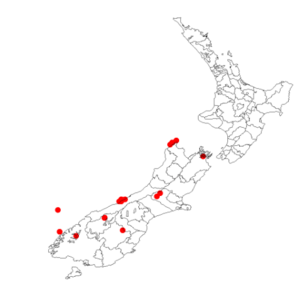Braided riverbed broom facts for kids
Quick facts for kids Braided riverbed broom |
|
|---|---|
| Conservation status | |
 Nationally Vulnerable (NZ TCS) |
|
| Scientific classification | |
| Kingdom: | |
| (unranked): | |
| (unranked): | |
| (unranked): | |
| Order: | |
| Family: | |
| Genus: | |
| Species: |
C. juncea
|
| Binomial name | |
| Carmichaelia juncea |
|
 |
|
| Where C. juncea has been found in New Zealand | |
Carmichaelia juncea, also called braided riverbed broom, is a special plant from New Zealand. It's a type of New Zealand broom that grows low to the ground. This plant belongs to the Fabaceae family, which includes peas and beans. Sadly, it has disappeared from many places where it used to grow, including the North Island.
Contents
Discovering the Braided Riverbed Broom
Sir Joseph Hooker's Journey
The C. juncea plant was first studied by a British explorer and botanist named Sir Joseph Hooker. In 1839, he joined an expedition to Antarctica. He worked as an assistant surgeon and naturalist on the ship HMS Erebus.
During the winter of 1841, Sir Joseph spent three months in the Bay of Islands in New Zealand. He collected many plants there. After returning to England, he kept in touch with plant collectors in New Zealand. He encouraged them and received plant samples for his collection. His first book about New Zealand plants, Flora Novae-Zelandiae, was published in 1853.
A Plant's Re-discovery
At first, scientists thought there were several types of Carmichaelia plants that looked similar. One of these was found along lake shores on the South Island's east coast. By 1993, this specific plant had not been seen for over 50 years. People thought it was extinct, meaning it had completely died out.
But then, something amazing happened! This plant was "re-discovered" growing in a rock garden at the Edinburgh Botanical Gardens. In 1995, scientists decided that many of these similar Carmichaelia plants were actually the same species. They were all grouped together as C. juncea. The name juncea means 'rush-like' in Greek, because the plant looks like a rush.
What C. juncea Looks Like
C. juncea is a low-growing shrub. It spreads out like a mat, about 20 centimeters (8 inches) tall and up to 1.5 meters (5 feet) wide. It often looks like a clump of dying rushes.
Its branches are thin and switch-like, light green to light brown. It has very few leaves. The flowers are small and white, with touches of purple. The seed pods are short and black. The seeds are likely spread by the wind. C. juncea flowers between October and January. It produces fruit between November and March.
Where C. juncea Lives
New Zealand has 23 different Carmichaelia species. Fourteen of these are listed as threatened or at risk. C. juncea usually grows in rocky places where other plants don't compete much. You can find it on open river flats, sandy or stony lake shores, and rocky spots along the coast.
Because it can survive in tough conditions, it's a good plant for rock gardens or growing in pots. C. juncea used to be found all over the North and South Islands. However, it was probably never very common because it needs specific places to grow.
Current Locations and Threats
Today, C. juncea is considered extinct in the North Island. In the South Island, it's only found in two areas. These are Puponga in North-West Nelson and a few spots in South Westland, from Franz Josef to Haast.
Like many New Zealand native plants, C. juncea is threatened by animals brought to New Zealand by people. For example, at Franz Josef, hares eat the plants so much that mature plants can barely produce seeds. The plant is also losing its habitat. This happens when braided rivers are changed. Also, because it grows low to the ground, introduced weeds can easily take over its space.
C. juncea is most closely related to C. compacta and C. curta. However, you can easily tell it apart because it grows flat on the ground.

